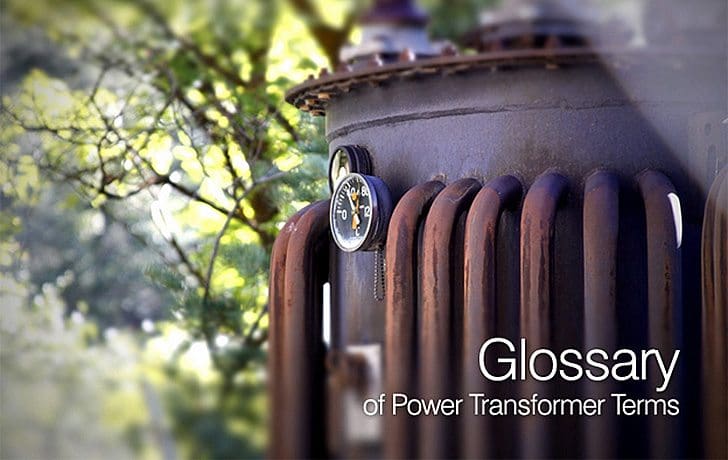
There are many terms associated with power and distributive transformers used in electrical networks. These are just some of the most important.
Feel free to add any of missing terms in the comment below ;)
Glossary
A B C D E F G H I K L M N O P R S T U V W
A
AA
An Ansi (American National Standard Institute) cooling class designation indicating open, natural-draft ventilated transformer construction, usually for dry-type transformers.
Ambient Temperature
The temperature of the surrounding atmosphere into which the heat of the transformer is dissipated.
Ampere
unit of current flow.
ANSI (American National Standards Institute)
An organization that provides written standards on transformer [6OOv and below (ANSI C89.1), 601~ and above (ANSI C57.12)].
Autotransformer
A transformer in which part of the winding is common to both the primary and the secondary circuits.
B
BIL
Basic Impulse Level, the crest (peak) value that the insulation is required to withstand without failure.
Bushing
An electrical insulator (porcelain, epoxy, etc.) that is used to control the high voltage stresses that occur when an energized cable must pass through a grounded barrier.
Buck transformer
Step down the Voltage from Primary Winding to Secondary Winding i.e. 460V to 230V.
Boost transformer
Step up the Voltage from Primary Winding to Secondary Winding i.e. 230V to 460V.
C
Cast-coil Transformer
A transformer with high-voltage coils cast in an epoxy resin. Usually used with 5 to 15 kV transformers.
Continuous Rating
Gaines the constant load that a transformer can carry at rated primary voltage and frequency without exceeding the specified temperature rise.
Copper Losses
See Load Losses.
Core-Form Construction
A type of core construction where the winding materials completely enclose the core.
Current Transformer
A transformer generally used in instrumentation circuits that measure or control current.
D
Delta
A standard three-phase connection with the ends of each phase winding connected in series to form a closed loop with each phase 120 degrees from the other. Sometimes referred to as 3-wire.
Delta Wye
A term or symbol indicating the primary connected in delta and the secondary in wye when pertaining to a three-phase transformer or transformer bank.
Distribution Transformers
Those rated 5 to 120 kV on the high-voltage side and normally used in secondary distribution systems. An aplicable standard is ANSI C-57.12.
Dripproof
Constructed or protected so that successful operation is not interfered with by falling moisture or dirt. A transformer in which the transformer core and coils are not immersed in liquid.
E
Exciting Current (No-load Current)
Current that flows in any winding used to excite the transformer when all other windings are open circuited. It is usually expressed in percent of the rated current of a winding in which it is measured.
F
FA
An ANSI cooling class designation indicating a forced air ventilated transformer, usually for dry type transformers and typically to increae the transformers and typically to increase the transformer’s KVA rating above the natural ventilation or AA rating.
Fan Cooled
Cooled mechanically to stay within rated temperature rise by addition of fans internally and/or externally. Normally used on large transformers only.
FOA
An ANSI cooling class designation indicating forced oil cooling using pumps to circulate the oil for increased cooling capacity.
FOW
An ANSI cooling class designation indicating forced oil water cooling using a separate water loop in the oil to take the heat to a remote heat exchanger. Typically used where air cooling is difficult such as underground.
Frequency
On AC circuits, designate number of times that polarity alternates from positive to negative and back again, such as 60 hertz (cycles per second).
G
Grounds or Grounding
Connecting one side of a circuit to the earth through low-resistance or low-impedance paths. This help prevent transmitting electrical shock to personnel. Also aids in the dissipation or mitigation of Noise (High frequency or other).
Ground Strap
A Flat Strap of varying density, width and length to aid in the dissipation of High frequency noise, commonly generated by Switching Power Supplies, Lighting Ballasts, Inverters or Variable Frequency Drives.
H
High-voltage and Low-voltage Windings
Terms used to distinguish the wind that has the greater voltage rating from that having the lesser in two-winding transformers. The terminations on the high-voltage windings are identified by H1, H2, etc., and on the low-voltage by X1, X2, etc.
I
Impedance
Retarding forces of current flow in AC circuits.
Indoor transformer
A transformer that, because of its construction, is not suitable for outdoor service.
Insulating Materials
Those materials used to electrically insulate the transformer windings from each other and to ground. Usually classified by degree of strength or voltage rating (0, A, B, C, and H).
Isolation transformer
For the purpose of isolating the Source Supply from the Consumer(s), aids in prevention of noise transmission, adds impedance, can also provide an isolated Ground on the secondary.
K
kVA or Volt-ampere Output Rating
The kVA or volt-ampere output rating designates the output that a transformer can deliver for a specified time at rated secondary voltage and rated frequency without exceeding the specified temperature rise (1 kVA = 1000 VA).
L
Liquid-immersed Transformer
A transformer with the core and coils immersed in liquid (as opposed to a dry-type transformer).
Load
The amount of electricity, in kVA or volt-amperes, supplied by the transformer. Loads are expressed as a function of the current flowing in the transformer, and not according to the watts consumed by the equipment the transformer feeds.
Load Losses
Those losses in a transformer that are incident to load carrying. Load losses include the I2R loss in the winding, core clamps, etc., and the circulating currents (if any) in parallel windings.
M
Mid-tap
A reduced-capacity tap midday in a winding – usually the secondary.
Moisture-resistant
Constructed or treated so as to reduce harm by exposure to a moist atmosphere.
Natural-draft or Natural-draft Ventilated
An open transformer cooled by the draft created by the chimney effect of the heated air in its enclosure.
N
No-load Losses (Excitation Losses)
Loss in a transformer that ls excited at its rated voltage and frequency, but which is not supplying load. No-load losses include core loss, dielectric loss, and copper loss in the winding due to exciting current.
O
OA
An ANSI cooling class designation indicating an oil filled transformer.
P
Parallel Operation
Single and three-phase transformers having appropriate terminals may be operated in parallel by connecting similarly-marked terminals, provided their ratios, voltages, resistances, reactances, and ground connections are designed to permit paralleled operation and provided their angular displacements are the same in the case of three-phase transformers.
Polarity Test
A standard test performed on transformers to determine instantaneous direction of the voltages in the primary compared to the secondary (see Transformer Tests).
Poly-phase
More than one phase.
Potential (Voltage) Transformer
A transformer used in instrumentation circuits that measure or control voltage.
Power Factor
The ratio of watts to volt-amps in a circuit.
Primary Taps
Taps added in the primary winding (see Tap).
Primary Voltage Rating
Designates the input circuit voltage for which the primary tiding is designed.
Primary Winding
The primary winding on the energy input (supply) side.
R
Rating
The output or input and any other characteristic, such as primary and secondary voltage, current, frequency, power factor and temperature rise assigned to the transformer by the manufacturer.
Ratio Test
A standard test of transformers used to determine the ratio of the primary to the secondary voltage.
Reactance
The effect of inductive and capacitive components of the circuit producing other than unity power factor.
Reactor
A device for introducing inductive reactance into a circuit for: motor starting, operating transformers in parallel, and controlling current.
S
Scott Connection
Connection for polyphase transformers. Usually used to change from two-phase to three-phase to three-phase to two-phase.
Sealed Transformer
A transformer completely sealed from outside atmosphere and usually contains an inert gas that is slightly pressurized.
Secondary Taps
Taps located in the secondary winding (see Tap).
Secondary Voltage Rating
Designates the load-circuit voltage for which the secondary winding (winding on the output side) is designed.
Series/Multiple
A winding of two similar coils that can be connected for series operation or multiple (parellel) operation.
Shell-type Construction
A type of transformer construction where the core completely surrounds the coil.
Star Connection
Same as wye connections.
Step-down Transformer
A transformer in which the energy transfer is from the high-voltage winding to the low-voltage winding or windings.
Step-up transformer
A transformer in which the energy transfer is from the low-voltage winding to a high-voltage winding or windings.
T
T-Connection
Use of Scott Connection for three-phase operation. A connection brought out of a winding at some point between its extremities, usually to permit changing the voltage or current ratio.
Temperature Rise
The increase over ambient temperature of the winding due to energizing and loading the transformer.
Total Losses
The losses represented by the sum of the no-load and the load losses.
Transformer
An electrical device, without continuously moving parts, which, by electro-magnetic induction, transforms energy from one or more circuits to other circuits at the same frequency, usually with changed values of voltage and current.
Turns Ratio (of a transformer)
The ratio of turns in the primary winding to the number of turns in the secondary winding.
V
Volt-amperes
Circuit volts multiplied by circuit amperes.
Voltage Ratio (of a transformer)
The ratio of the RMS primary terminal voltage to the RMS secondary terminal voltage under specified conditions of load.
Voltage Regulation (of a transformer)
The change in secondary voltage that occurs when the load is reduced from rated value to zero, with the values of all other quantities remaining unchanged. The regulation may be expressed in percent (or per unit) on the basis of the rated secondary voltage at full load.
W
Winding Losses
See Load Losses.
Winding Voltage Rating
Designates the voltage for which the winding is designed
Wye Connection (Y)
A standard three-phase connection with similar ends of the single-phase coils connected to a common point. This common point forms the electrical neutral point and may be grounded.
Reference: Power transformer maintenance and accepting testing – Department of the Army TM 5686

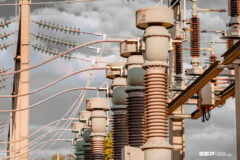
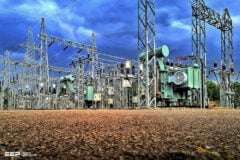
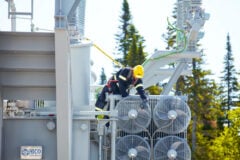

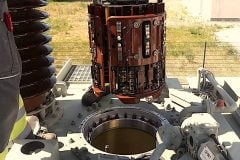
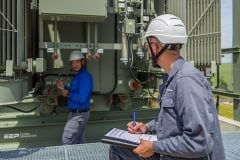
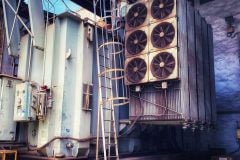



Hi
As an electrician by trade I found I’m ready to go into electrical testing with all the information I’m receiving
Looking for information on transformer maintenance including tap changer
Regards
Under “B”
Bucholz Relay : A gas Operated relay for detection of incipient faults in transformer
Under “I”
Inrush Current : The current Drawn by transformer while switching ON.
Hello, Thanks for posting the complete details about the Transformers and related stuffs,Very useful
Thank you
good collection..:)
In ” V” , I did not find Vector Group ?
Add Under B:
Buck transformer – Step down the Voltage from Primary Winding to Secondary Winding i.e. 460v to 230v
Boost transformer – Step up the Voltage from Primary Winding to Secondary Winding i.e. 230v to 460v
Add Under I:
Isolation transformer – For the purpose of isolating the Source Supply from the Consumer(s), aids in prevention of noise transmission, adds impedance, can also provide an isolated Ground on the secondary.
Add under G:
Ground Strap: A Flat Strap of varying density, width and length to aid in the dissipation of High frequency noise, commonly generated by Switching Power Supplies, Lighting Ballasts, Inverters or Variable Frequency Drives.
Modify or add to:
Grounds or Grounding : Also aids in the dissipation or mitigation of Noise (High frequency or other).
Thank you for the opportunity to contribute.
Excellent add! Thanks Bdsisler, I added all of your suggestions.